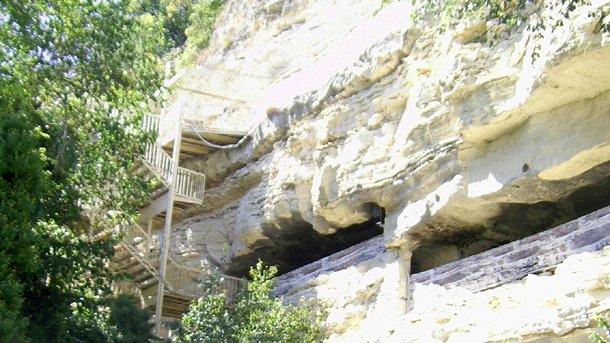
© Photo: Albena Bezovska

© Photo: Albena Bezovska

© Photo: Albena Bezovska
Although this place has not been dwelled for centuries we can clearly delimit the basic chambers of the monastery. They are situated in 2 levels- monk cells, a chapel, a temple for requiescats and a crypt. The chambers, which were once used as a kitchen and living room by the monks, are well preserved inside the rocks. On the first level, right next to the wooden staircase used by the tourists, is the monastery church. A sanctuary recess was carved into the eastern wall of the church. Only some of its frescoes were preserved though. Scientists claim that the upper layer of icon-paintings dates back to the end of the 18th century. Under this layer there is another one, which takes us to the 16th-17th century.

© Photo: Albena Bezovska

© Photo: Albena Bezovska
A stone ladder was made inside the floor of the church. It takes us to 6 monk cells. Remains of small niches in the walls of these cells can still be seen there. The monks used to place their icons and personal belongings there. Later the museum employees placed pictures over some of these niches. The paintings portray the life of the monks from Aladzha monastery. This was the only change made in the monastery except for the multiple notes taken by Bulgarian and foreign tourists, where all their dearest wishes were written. This happens despite the huge sign, which prohibits people from placing any kind of notes in the niches. According to a local belief, the souls of the monks continue to haunt the monastery. And if someone meekly shares his desires with them, they will make them come true.
There are many legends about Aladzha monastery. One of the most popular ones says that the spirit of one of the monks who lived there appears from time to time asking whether there are still trees in this locality or not and if women in this area still give birth. If the answer is positive, the spirit disappears. Before leaving this place it says that if people stop living on these lands something mystical will happen.

© Photo: Albena Bezovska
The Bulgarians still keep their traditional beliefs and feel the special energy of this place. That is why the monastery is constantly visited by tourists, who can plunge into the history if this tourist site. Young and cheerful people meet the tourists in the museum, which is situated next to the entrance. They show the exposition to the tourists and provide interesting facts about the monastery books, which were translated in several foreign languages. You can also meet there a silent man from the town of Varna. He is an electrician but also practices wood-carving. There he makes the sculptures of the monks who once lived in the monastery and brought a lot faith to this place.
English version: Kostadin Atanasov
It was in the vicinity of one of the Devnya karst springs in the Roman province of Lower Moesia (Moesia inferior) that the Roman Emperor Trajan (98-177 AD) stopped with his army. His sister Marcia sent her maid to fetch water, but..
In 2000 archaeologist Dr. Georgi Kitov and his team discovered, in the Roshava Chuka mound in the vicinity of Alexandrovo village near Haskovo, a Thracian tomb dated to the 4 th century BC. The high artistic value of the frescoes and the..
The feet of Thracians, Greeks, Macedonians, Romans, Illyrians, Celts, and Egyptians walked along the marble slabs of the polis square. Streets branched towards temples, ateliers and shops, while the forum was the place to look for justice and to..

+359 2 9336 661
